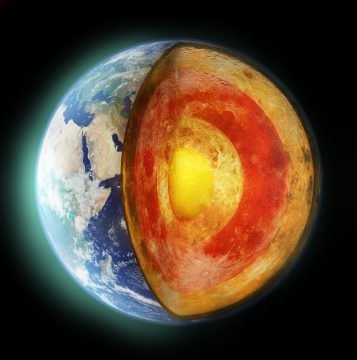Scientists may have solved a question that has baffled humans since ancient times – where did gold come from?
This resource is best suited to Year 8, 9, 11 and 12 Chemistry and Earth Science students. It works well as a real-world application of learning about elements, their formation and the Earth’s composition.
Word count: 394

“The search for gold has motivated migrations, expeditions and even wars, but its origin is one of the main questions in the field of mineral deposits genesis,” said researcher José María González Jiménez from the University of Granada, who was involved in the international study to find out.
Part of the problem is that, as far as the Earth goes, we have (literally) hardly scratched the surface.
The Earth is divided into three large layers: crust, mantle and core.
“The minerals we extract and which support our economy are located in the crust. And, although we are experts in taking advantage of them, we still know very little about their true origin,” says González Jiménez.
The mantle’s upper limit lies about 17 kilometres beneath the oceans and 70 kilometres under the continents – distances beyond our ability to reach.
But thanks to volcanic activity, the mantle can sometimes come to us, with eruptions bringing small fragments, or “xenoliths”, from the mantle to the surface.

In these rare xenoliths from the Argentinian Patagonia region, Jiménez and his colleagues discovered tiny native gold particles, no more than the thickness of a human hair, which had come upon from deep in the mantle, at a depth of 70 kilometres.
The region of the Deseado Massif is one of the largest auriferous (gold-producing) provinces in the world, where gold mines have been producing the metal since ancient times.
The researchers hypothesise that mineral deposits are limited to some specific regions of the planet because the mantle under those regions are unique. In the case of Patagonia, the mantle has a tendency to generate gold deposits.
The history dates back 200 million years, when Africa and South America were part of the same continent, González Jiménez says. Their separation was caused, among other factors, by the ascent of a “mantle plume”, which broke the crust, separating the two continents.
The ascent of this deep mantle plume “generated a true chemical factory that enriched the mantle with metals, which would later generate the conditions for the creation of gold deposits”, González Jiménez says.
“This time the process was caused by the movement of a tectonic plate under another, allowing the circulation of metal-rich fluids through the cracks, which precipitated the metals and concentrated them near the surface.”
The researchers involved in the study, which was published in Nature Communications, came from Chile, France and Macquarie University and the University of New England in Australia.
Login or Sign up for FREE to download a copy of the full teacher resource





